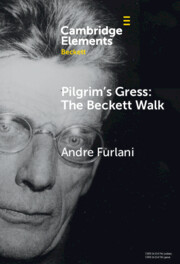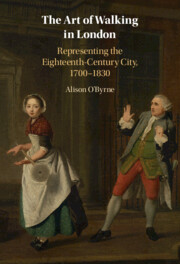Refine search
Actions for selected content:
56 results
Chapter 3 - The Scriblerian Mock Arts
-
- Book:
- Satire, Instruction and Useful Knowledge in Eighteenth-Century Britain
- Published online:
- 24 April 2025
- Print publication:
- 08 May 2025, pp 51-83
-
- Chapter
-
- You have access
- Open access
- Export citation
Why and How to Walk a City
-
- Journal:
- Asia-Pacific Journal / Volume 21 / Issue 12 / December 2023
- Published online by Cambridge University Press:
- 14 March 2025, e1
-
- Article
-
- You have access
- Open access
- Export citation

Pilgrim's Gress: The Beckett Walk
-
- Published online:
- 12 March 2025
- Print publication:
- 27 March 2025
-
- Element
- Export citation
Kinematic design and analysis of a novel overconstraint walking mechanism
-
- Article
-
- You have access
- Open access
- HTML
- Export citation
Predictive control of musculotendon loads across fast and slow-twitch muscles in a simulated system with parallel actuation
-
- Journal:
- Wearable Technologies / Volume 6 / 2025
- Published online by Cambridge University Press:
- 20 February 2025, e8
-
- Article
-
- You have access
- Open access
- HTML
- Export citation
Chapter 5 - Metropolitan Pleasures and Grievances
-
- Book:
- The Art of Walking in London
- Published online:
- 19 December 2024
- Print publication:
- 23 January 2025, pp 191-234
-
- Chapter
- Export citation

The Art of Walking in London
- Representing the Eighteenth-Century City, 1700–1830
-
- Published online:
- 19 December 2024
- Print publication:
- 23 January 2025
Effects of pre-exercise high and low glycaemic index meals on substrate metabolism and appetite in middle-aged women
-
- Journal:
- Journal of Nutritional Science / Volume 12 / 2023
- Published online by Cambridge University Press:
- 20 November 2023, e114
-
- Article
-
- You have access
- Open access
- HTML
- Export citation
Chapter 5 - The Neighborhood and the Sweatshop
- from Part II - Spotlight Literary Cities
-
-
- Book:
- The Cambridge Companion to the City in World Literature
- Published online:
- 13 July 2023
- Print publication:
- 27 July 2023, pp 67-82
-
- Chapter
- Export citation
Conclusion - Towards a Deep History of Landscape
-
- Book:
- Lifescapes
- Published online:
- 20 April 2023
- Print publication:
- 11 May 2023, pp 410-456
-
- Chapter
- Export citation
Factors Associated with Outdoor Winter Walking in Older Adults: A Scoping Review
-
- Journal:
- Canadian Journal on Aging / La Revue canadienne du vieillissement / Volume 42 / Issue 2 / June 2023
- Published online by Cambridge University Press:
- 02 December 2022, pp. 316-327
-
- Article
-
- You have access
- Open access
- HTML
- Export citation
Chapter 5 - Walking the Dharma on Shikoku and in India
-
- Book:
- Journeys of Transformation
- Published online:
- 12 March 2022
- Print publication:
- 31 March 2022, pp 123-149
-
- Chapter
-
- You have access
- HTML
- Export citation
Patterns of older Australians’ engagement in health-promoting activities: a latent profile analysis
-
- Journal:
- Ageing & Society / Volume 42 / Issue 5 / May 2022
- Published online by Cambridge University Press:
- 16 October 2020, pp. 1176-1190
- Print publication:
- May 2022
-
- Article
- Export citation
water/watery/watering: Concepts for Theorising in Environmental Education
-
- Journal:
- Australian Journal of Environmental Education / Volume 36 / Issue 2 / July 2020
- Published online by Cambridge University Press:
- 25 September 2020, pp. 146-168
-
- Article
- Export citation
17 - Action in Development
- from Part IV - Action
-
-
- Book:
- The Cambridge Handbook of Infant Development
- Published online:
- 26 September 2020
- Print publication:
- 13 August 2020, pp 469-494
-
- Chapter
- Export citation
Chapter 9 - The Marvellous and the Mundane
- from Part II - Innovation and Inspiration
-
-
- Book:
- New York
- Published online:
- 19 February 2020
- Print publication:
- 27 February 2020, pp 123-136
-
- Chapter
- Export citation
Chapter 19 - Walking the City
- from Part IV - Tragedy and Hope
-
-
- Book:
- New York
- Published online:
- 19 February 2020
- Print publication:
- 27 February 2020, pp 265-284
-
- Chapter
- Export citation
2 - Functional Morphology of the Pelvis
-
- Book:
- The Evolutionary Biology of the Human Pelvis
- Published online:
- 30 December 2019
- Print publication:
- 16 January 2020, pp 33-45
-
- Chapter
- Export citation
Walking, pointing, talking – the predictive value of early walking and pointing behavior for later language skills
-
- Journal:
- Journal of Child Language / Volume 46 / Issue 6 / November 2019
- Published online by Cambridge University Press:
- 22 August 2019, pp. 1228-1237
-
- Article
- Export citation

